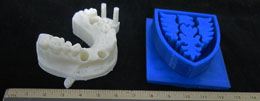3D Printing
What is 3D Printing?
3D printing is the process of creating physical objects from a digital model. This technology has been around since the 1980s, used mostly by engineers and industry designers.
3D Printing at Dalhousie Libraries
The Dalhousie Libraries have purchased a set of Ultimaker 3 3D printers. They are located in the Help Desk in the Killam Library, and the Circulation Desks in the Sexton and MacRae Libraries.
They use PLA filament; a bio-degradable polymer that can be produced from lactic acid, which can be fermented from crops such as maize.
The current colours available are posted above. The cost of printing a 3D model is based on its weight. The charge will be 8 cents per gram.
Preparing your 3D File for Printing
Your 3D file must be in binary STL, or stereolithographic file format, for printing. Most 3D modeling programs, such as AutoCAD and Rhino3D, will export 3D files to this format. If your 3D program does not export to the STL format, you can use the MeshLab freeware available on the Learning Commons computers to convert your file to STL format.
Printing Your STL File
Files in binary STL format should be submitted via the 3D Printing Request Form. Multiple STL files can be submitted in ZIP format. Once submitted an email will be received containing a ticket number which is required for tracking purposes. Reply to that email if you have any questions about your order. Please note, Academic submissions will take priority.

Sample models.
Picking up Your Model
When notified by e-mail ticket that your model is ready go to the chosen pick up location. You will be given a receipt for your model listing the print cost. Take this receipt to the Killam Library Service Point to make your payment, then return with the second receipt to collect your model.
What to expect:
The Ultimaker 3 is best at printing objects designed from the ground up. Objects that contain extreme overhangs—or where large parts of the object are suspended in mid-air—will not print as well as objects without overhangs.
Errors in a 3D print depend on a number of factors:
● Was the STL file too complex?
● Was there something wrong with your 3D software program’s settings?
● Is PLA plastic a suitable material for printing this object?
STL Files
Create a 3D model from scratch
There’s a wealth of 3D modeling software out there that can use to create a digital object. Some are easier to use than others.
SolidEdge (available on Sexton campus only), is an advanced software program which allows users to create complex 3D models.
FreeCAD and OpenSCAD are two free CAD (computer-aided design) software packages available online. If you’re new to 3D modeling, you may want to try Sketchup 8. It’s fairly easy to use, and has an export to STL plugin.
Download an STL file
There are a number of places where you can browse and download 3D models. Here are two examples:
Makerbot's THINGIVERSE.COM: users can submit their 3D models to this database to make them available for free downloads. Many of these objects print well on the Ultimaker.
shapeways.com is a searchable database of 3D model designs for purchase. Many of the 3D models on display on Shapeways require the precision of higher-end 3D printers, able to deal with overhangs and print materials other than plastic.
Use Dalhousie Libraries’ 3D repository
Browse 3D models, as well as upload and download your own creations or derivatives, which are available around the world.
Questions?
If you have any general questions about our 3D printing service please email support@dal.ca. If you have any questions about an existing order please reply to the acknowledgement email that you received when the order was submitted. To submit a model for printing please use the 3D Printing Request Form.
